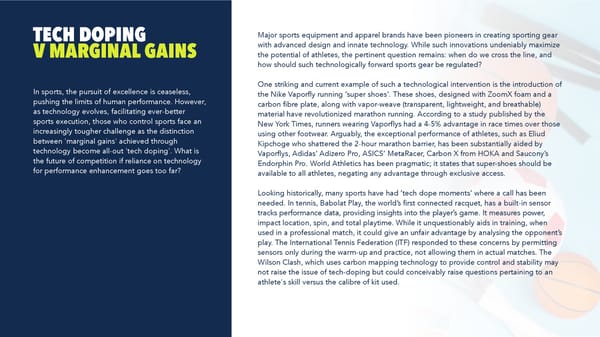TECH DOPING Major sports equipment and apparel brands have been pioneers in creating sporting gear with advanced design and innate technology. While such innovations undeniably maximize V MARGINAL GAINS the potential of athletes, the pertinent question remains: when do we cross the line, and how should such technologically forward sports gear be regulated? One striking and current example of such a technological intervention is the introduction of In sports, the pursuit of excellence is ceaseless, the Nike Vaporfly running ‘super shoes’. These shoes, designed with ZoomX foam and a pushing the limits of human performance. However, carbon fibre plate, along with vapor-weave (transparent, lightweight, and breathable) as technology evolves, facilitating ever-better material have revolutionized marathon running. According to a study published by the sports execution, those who control sports face an New York Times, runners wearing Vaporflys had a 4-5% advantage in race times over those increasingly tougher challenge as the distinction using other footwear. Arguably, the exceptional performance of athletes, such as Eliud between 'marginal gains' achieved through Kipchoge who shattered the 2-hour marathon barrier, has been substantially aided by technology become all-out 'tech doping'. What is Vaporflys, Adidas’ Adizero Pro, ASICS’ MetaRacer, Carbon X from HOKA and Saucony’s the future of competition if reliance on technology Endorphin Pro. World Athletics has been pragmatic; it states that super-shoes should be for performance enhancement goes too far? available to all athletes, negating any advantage through exclusive access. Looking historically, many sports have had ‘tech dope moments’ where a call has been needed. In tennis, Babolat Play, the world’s first connected racquet, has a built-in sensor tracks performance data, providing insights into the player’s game. It measures power, impact location, spin, and total playtime. While it unquestionably aids in training, when used in a professional match, it could give an unfair advantage by analysing the opponent’s play. The International Tennis Federation (ITF) responded to these concerns by permitting sensors only during the warm-up and practice, not allowing them in actual matches. The Wilson Clash, which uses carbon mapping technology to provide control and stability may not raise the issue of tech-doping but could conceivably raise questions pertaining to an athlete's skill versus the calibre of kit used.
 The Sports Technology Annual Review 2023 Page 39 Page 41
The Sports Technology Annual Review 2023 Page 39 Page 41This is a modal window.

